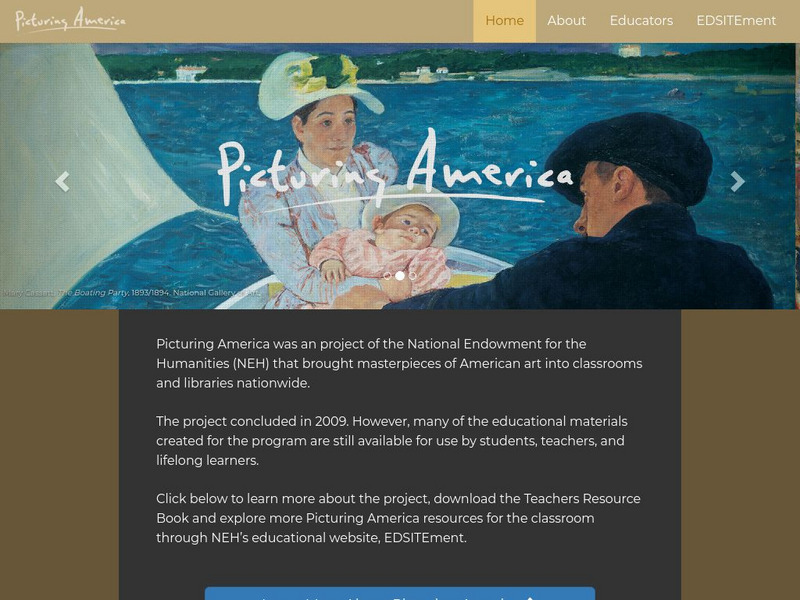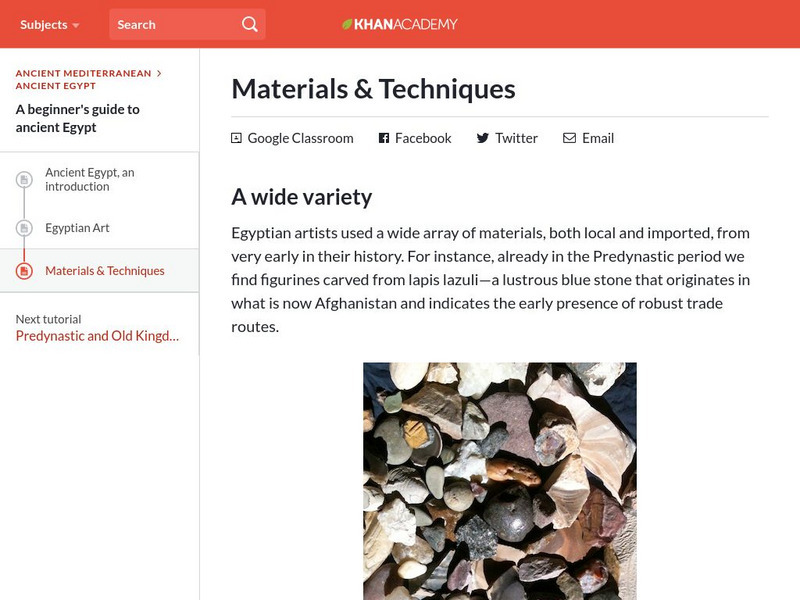Hi, what do you want to do?
Metropolitan Museum of Art
Metropolitan Museum of Art: Mesopotamia
The Metropolitan Museum of Art image of Mesopotamian sculpture. Click on "Description," to get the full story. There are links to other information within the MET as well.
National Endowment for the Humanities
Neh: Picturing America
In this gallery you will encounter art of America in a completely new fashion. Taking a look at various paintings, sculpture, architecture, fine crafts, and photography provides an inside look at our nation's character and ideals. Learn...
Smithsonian Institution
Smithsonian American Art Museum: Johnson Antonio
As part of the Smithsonian Art Museum's database of artists, this site provides biographical information on Johnson Antonio. Antonio was a Navajo artist who, through carving secular human figures, went against traditional Native American...
Khan Academy
Khan Academy: Oldenburg, Lipstick (Ascending) on Caterpillar Tracks
A monumental tube of lipstick sprouting from a military vehicle appeared, uninvited, on the campus of Yale University amidst the 1969 student protests against the Vietnam War. Claes Oldenburg made this sculpture and it served as a stage...
Khan Academy
Khan Academy: Hiram Powers, the Greek Slave
"The Greek Slave" secured Hiram Powers's reputation as an American sculptor of the highest rank and it remains one of the most important and enduring works of American sculpture. It even inspired a poem by Elizabeth Barrett Browning....
Khan Academy
Khan Academy: Portrait of King Mishe Mishyaang Mambul (Kuba Peoples)
The ndop statues might be the most revered of all Kuba art forms. The ndop (literally meaning "statue") are a genre of figurative wood sculpture that portrays important Kuba leaders throughout the eighteenth to twentieth centuries. View...
Khan Academy
Khan Academy: Sarcophagus of the Spouses (Rome)
The Sarcophagus of the Spouses is a masterwork of terracotta sculpture and conveys a great deal of information about Etruscan culture and its customs, especially funeral customs. View pictures and read descriptions of the sarcophagus in...
Khan Academy
Khan Academy: Polykleitos, Doryphoros (Spear Bearer)
Greek art became popular when Roman generals began conquering Greek cities. This work so impressed the Roman elite that studios were set up to meet the growing demand for copies. The Doryphoros was one of the most sought after, and most...
Khan Academy
Khan Academy: Head of a Roman Patrician
Verism can be defined as a sort of hyperrealism in sculpture where the naturally occurring features of the subject are exaggerated, often to the point of absurdity. Roman portraiture used this artistic preference to show leaders as...
Khan Academy
Khan Academy: Shiva as Lord of the Dance (Nataraja)
The art of medieval India, like the art of medieval Europe, was primarily in the service of religion. The supple and expressive quality of the dancing Shiva is one of the touchstones of South Asian, and indeed, world sculpture. View...
Curated OER
Dumbarton Oaks Museum: Pre Columbian Collection: Pre Columbian Sculpture
Pre-Columbian sculpture.
Other
Italian renaissance.org: Basic Ideas of the Renaissance
Basic information about the Renaissance. Looks at Early Renaissance, High Renaissance, painting, and sculpture. Touches upon humanism.
Khan Academy
Khan Academy: Bodhisattva Avalokiteshvara
This is an image of the compassionate and merciful bodhisattva Avalokiteshvara. Bodhisattvas are enlightened beings who are destined to become buddhas but postpone that final state in order to help humanity. The name Avalokiteshvara...
Khan Academy
Khan Academy: Haniwa in the Form of a Warrior
This object is a haniwa (lit. "clay ring"), a type of funerary article made during the Kofun era (300-552). Many kinds of haniwa have been found, including both simple clay cylinders and more elaborate forms, such as human figures,...
Khan Academy
Khan Academy: Terms and Materials: Fashion
Art moves fashion designers to play with unusual forms and shapes, while fashion can encourage artists to think about qualities such as texture and create art that engages with the human body. Take a look through this glossary for terms...
Khan Academy
Khan Academy: Materials and Techniques
Ancient Egyptians used a wide variety of techniques to make their unparalleled artwork. Stone, paint, wood, metal, relief sculpture, and pigments are described with pictures. A question/answer section from the community is also included.
Smithsonian Institution
Smithsonian American Art Museum: William King
As part of the Smithsonian Art Museum's database of artists, William King is described here along with information on his contributions to art through sculptures of male subjects with long, lanky legs which he used to "explore human...
Khan Academy
Khan Academy: Camelid Sacrum in the Shape of a Canine
This fascinating and unique prehistoric sculpture of a dog-like animal was discovered accidentally in 1870 in Tequixquiac, Mexicocan. Anthropologists are not certain of this object's original meaning for either the artist or the people...
Khan Academy
Khan Academy: Ambum Stone
The Ambum Stone is prized above all others not only for its age-it is one of the oldest of all sculptures made in Oceania-but also for its highly detailed sculptural qualities. View pictures and read about the history and mysteries...
Khan Academy
Khan Academy: Rodin, the Burghers of Calais
In 1885, Rodin was commissioned by the French city of Calais to create a sculpture that commemorated the heroism of Eustache de Saint-Pierre, a prominent citizen of Calais, during the Hundred Years' War between England and France. View...
Khan Academy
Khan Academy: Seated Amitabha Buddha (Amida Nyorai)
This sculpture shows Amitabha, identified as the Buddha of the Western Paradise. Read a brief history of Amitabha and the techniques used to make this sculpture.
Khan Academy
Khan Academy: The Neolithic Revolution
During the Neolithic period, people settle down and begin to live in one place, year after year. This leads to massive changes in art. Neolithic sculpture became bigger, in part, because people didn't have to carry it around anymore;...
Khan Academy
Khan Academy: Maize Cobs
Inka visual expression often incorporated more naturalistic forms in small-scale metal objects. This silver alloy corncob sculpture is one example of this type of object. View pictures and read about this-form of Incan art.
Khan Academy
Khan Academy: Mexican Muralism: Los Tres Grandes David Siqueiros, Diego Rivera
Siqueiros, Diego Rivera, and Jose Clemente Orozco-known as Los tres grandes-cultivated an artistic style that defined Mexican identity following the Revolution. They crafted epic murals on the walls of highly visible, public buildings...
Other popular searches
- Recycled Human Sculpture
- Abstract Human Sculpture
- Mixed Media Human Sculpture
- Human Sculpture Packing Tape
- Wire Sculpture Human Faces
- Human Sculpture Mache
- Human Sculpture Tape
- Human Sculpture Mac He
- Wire Sculpture, Human Faces



























